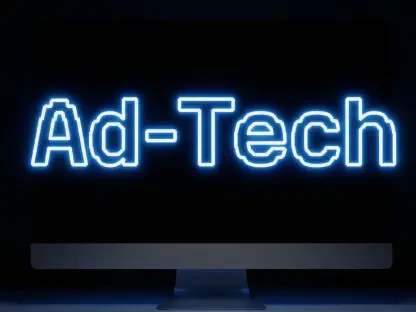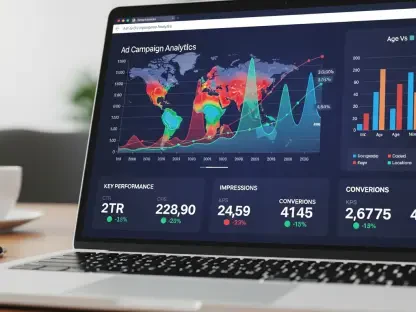Setting the Stage for a Marketing Revolution
Imagine a world where digital advertising campaigns adjust themselves in real-time, targeting precisely the right audience without a marketer lifting a finger. This isn’t a distant dream but a reality unfolding in 2025, driven by the transformative power of artificial intelligence (AI). The digital advertising landscape has undergone a seismic shift, with AI evolving from a niche experiment to a critical tool that shapes media buying and campaign optimization. Backed by extensive global studies involving thousands of marketing decision-makers, this technology is redefining efficiency and effectiveness in ways previously unimaginable.
The significance of AI in this sphere cannot be overstated. It has emerged as a cornerstone for reducing operational costs while amplifying campaign outcomes across diverse industries. As marketers grapple with ever-increasing data complexity, AI offers a lifeline by automating processes and delivering insights at unprecedented speeds. This review delves into how this technology is reshaping digital advertising, exploring its core capabilities and real-world impact.
Unpacking AI’s Capabilities in Advertising
Automating the Mundane for Strategic Gains
One of AI’s standout features in digital advertising is its ability to automate repetitive, time-intensive tasks. A significant portion of marketers—around 26%—have historically spent over 10 hours weekly on manual optimization, a burden that AI now alleviates. By handling routine adjustments and data crunching, this technology frees up valuable time for professionals to focus on high-level strategy and creative planning.
Beyond time savings, AI enhances budget efficiency through streamlined processes. Automated systems analyze performance metrics continuously, ensuring resources are allocated to the most effective channels without human intervention. This reduction in workload translates into measurable cost benefits, allowing teams to prioritize innovation over operational drudgery.
Real-Time Adjustments for Dynamic Campaigns
Another critical strength of AI lies in its capacity for real-time campaign optimization. With a reported 12% increase in planned adoption among marketers, this feature enables instantaneous adjustments based on live data inputs. Whether it’s shifting ad placements or tweaking messaging, AI ensures campaigns remain agile in response to fluctuating market conditions.
The impact on performance is profound. Dynamic optimization means advertisements are more relevant and timely, directly improving engagement rates and return on investment. This adaptability sets AI apart as an indispensable asset for advertisers aiming to stay competitive in a fast-paced digital environment.
Precision Targeting to Reach the Right Audience
AI’s prowess in audience targeting represents a leap forward in advertising precision. Projections indicate a staggering 106% increase in upper-funnel activations, signaling a surge in engagement with potential customers at the awareness stage. This capability stems from AI’s ability to sift through vast datasets to identify and segment audiences with unparalleled accuracy.
Specific applications include crafting tailored messages for niche demographics and predicting consumer behavior with high reliability. Such precision ensures that marketing efforts resonate more deeply, driving conversions while minimizing wasted impressions. This targeted approach is a game-changer for campaigns seeking maximum impact.
Streamlining Launch Processes for Efficiency
The efficiency of campaign activation is yet another area where AI shines. A notable 32% rise in planned adoption highlights its growing relevance, particularly in sectors like food and technology. By automating setup workflows, AI slashes the time required to launch initiatives, enabling brands to hit the market faster.
This streamlining extends to operational benefits, reducing the friction often associated with campaign rollouts. Marketers can manage larger volumes of projects without compromising on quality, thanks to AI’s systematic handling of logistics. The result is a smoother, more responsive advertising ecosystem.
Current Trends and Adoption Patterns
The integration of AI into digital advertising is accelerating at a remarkable pace. Currently, 42% of marketers utilize third-party AI or automated bidding tools, with an additional 49% planning to adopt them in the near future. This widespread acceptance underscores a collective recognition of AI’s value in enhancing operational workflows.
Investment in this technology is also on a sharp upward trajectory, with 92% of companies intending to boost funding for AI initiatives. However, full deployment maturity remains elusive, with only 1% achieving comprehensive integration. This gap points to a critical need for further refinement and scalability in implementation strategies.
Emerging priorities include leveraging AI for innovative solutions like navigating challenges in restricted environments such as social video platforms. As ad spend in these spaces continues to grow, AI’s role in optimization and independent verification becomes increasingly vital. These trends signal a future where AI is not just an option but a necessity for staying ahead.
Real-World Impact and Applications
AI’s influence is evident across various advertising sectors, transforming how campaigns are managed and executed. Real-time bidding, for instance, has become a cornerstone of programmatic advertising, allowing for split-second decisions that maximize ad placement value. This practical application showcases AI’s ability to drive tangible results.
In navigating the complexities of walled gardens like social video platforms, AI offers unique solutions through optimization and verification tools. These environments, with their massive ad spend potential, benefit from AI’s capacity to ensure transparency and effectiveness despite restricted access to data. Such capabilities are proving essential for modern marketers.
Notable implementations further illustrate AI’s value, with case studies revealing significant uplifts in campaign performance. From personalized ad experiences to predictive analytics that anticipate market shifts, these examples highlight how AI turns theoretical potential into measurable success. The technology’s footprint is expanding, reshaping advertising norms industry-wide.
Challenges Hindering Wider Adoption
Despite its promise, AI adoption in digital advertising faces substantial hurdles. A primary obstacle is hesitance among leadership, often rooted in cultural or strategic apprehensions rather than technical unreadiness. This reluctance slows the pace of integration, even as the technology proves its worth.
Organizational resistance also plays a role, with concerns about over-reliance on automation impacting decision-making. Balancing AI’s capabilities with human oversight remains a point of contention, as companies strive to maintain control over brand narratives. Addressing these issues requires a shift in mindset at the executive level.
Efforts to build confidence in AI are underway, focusing on ethical standards and transparent practices. By demonstrating reliability and aligning with industry values, stakeholders aim to overcome barriers. This ongoing work is crucial for unlocking AI’s full potential in advertising contexts.
Future Prospects and Industry Evolution
Looking ahead, AI is poised to become even more integral to digital advertising. Advancements in automation and data processing are expected to refine its capabilities, enabling deeper insights and more sophisticated campaign strategies. The trajectory suggests a tighter integration into everyday marketing operations.
Long-term impacts include sustained cost reductions and enhanced targeting precision, alongside greater transparency in ad ecosystems. These developments promise to reshape how brands connect with consumers, fostering trust and efficiency. AI’s evolution will likely redefine competitive benchmarks across the board.
The partnership between AI and human marketers is set to deepen, striking a balance between technological efficiency and creative intuition. This collaboration will be key to addressing ethical considerations while pushing boundaries in innovation. The future of advertising hinges on this symbiotic relationship.
Reflecting on AI’s Journey in Advertising
Looking back, AI’s integration into digital advertising marked a turning point for the industry, delivering unprecedented automation and optimization that reshaped campaign management. Its ability to handle repetitive tasks, adjust strategies on the fly, and target audiences with precision stood out as transformative achievements. Yet, challenges like leadership hesitancy and the need for ethical frameworks underscored that technology alone isn’t the full solution.
Moving forward, the industry must prioritize actionable strategies to bridge adoption gaps, such as investing in training programs to align leadership with AI’s potential. Fostering a culture that values both data-driven insights and human creativity will be essential. As the next steps unfold, exploring hybrid models that empower marketers while leveraging AI’s strengths will pave the way for a more dynamic and responsible advertising landscape.









